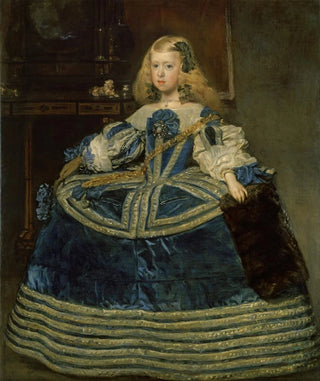Art print | Infante Margaret Teresa in a blue dress - Diego Velázquez


View from behind

Frame (optional)
The art print "Infante Margaret Teresa in a blue dress" by Diego Velázquez is a masterpiece of Spanish Baroque painting, continuing to captivate art enthusiasts with its brilliance and depth. Painted in 1659, this depiction of the young infanta, daughter of King Philip IV of Spain, transcends a simple portrait to become a true ode to royal childhood. The graceful posture of the infanta, her delicate features, and the richness of the details in her blue dress capture the very essence of nobility, while revealing Velázquez's technical virtuosity. Through this work, the artist succeeds in establishing a dialogue between the viewer and the subject, inviting each to contemplate not only external beauty but also innocence and fragility of childhood.
Style and uniqueness of the work
Velázquez's style is distinguished by its realistic approach and its ability to play with light and shadow. In "Infante Margaret Teresa in a blue dress," the light seems to dance across the sumptuous fabrics, creating a depth effect that brings the scene to life. The blue dress, adorned with meticulous details, is a striking example of Velázquez's mastery in representing textures. The colors, both vivid and nuanced, testify to his skill in capturing the subtleties of flesh and clothing. The composition is skillfully balanced, with a blurred background that emphasizes the expressive face of the infanta. This stylistic choice allows the viewer to focus on the emotions conveyed by the child, while admiring the artist's impeccable technique. Thus, the work is not limited to a simple portrait but becomes a window into the soul of an era marked by power and beauty.
The artist and his influence
Diego Velázquez, considered one of the greatest masters of painting, knew how to leave his mark on his era through his innovation and artistic vision. Born in 1599 in Seville, he quickly gained favor at the Spanish court, becoming the official painter of Philip IV. His œuvre, rich in portraits of the nobility

Matte finish

View from behind

Frame (optional)
The art print "Infante Margaret Teresa in a blue dress" by Diego Velázquez is a masterpiece of Spanish Baroque painting, continuing to captivate art enthusiasts with its brilliance and depth. Painted in 1659, this depiction of the young infanta, daughter of King Philip IV of Spain, transcends a simple portrait to become a true ode to royal childhood. The graceful posture of the infanta, her delicate features, and the richness of the details in her blue dress capture the very essence of nobility, while revealing Velázquez's technical virtuosity. Through this work, the artist succeeds in establishing a dialogue between the viewer and the subject, inviting each to contemplate not only external beauty but also innocence and fragility of childhood.
Style and uniqueness of the work
Velázquez's style is distinguished by its realistic approach and its ability to play with light and shadow. In "Infante Margaret Teresa in a blue dress," the light seems to dance across the sumptuous fabrics, creating a depth effect that brings the scene to life. The blue dress, adorned with meticulous details, is a striking example of Velázquez's mastery in representing textures. The colors, both vivid and nuanced, testify to his skill in capturing the subtleties of flesh and clothing. The composition is skillfully balanced, with a blurred background that emphasizes the expressive face of the infanta. This stylistic choice allows the viewer to focus on the emotions conveyed by the child, while admiring the artist's impeccable technique. Thus, the work is not limited to a simple portrait but becomes a window into the soul of an era marked by power and beauty.
The artist and his influence
Diego Velázquez, considered one of the greatest masters of painting, knew how to leave his mark on his era through his innovation and artistic vision. Born in 1599 in Seville, he quickly gained favor at the Spanish court, becoming the official painter of Philip IV. His œuvre, rich in portraits of the nobility






